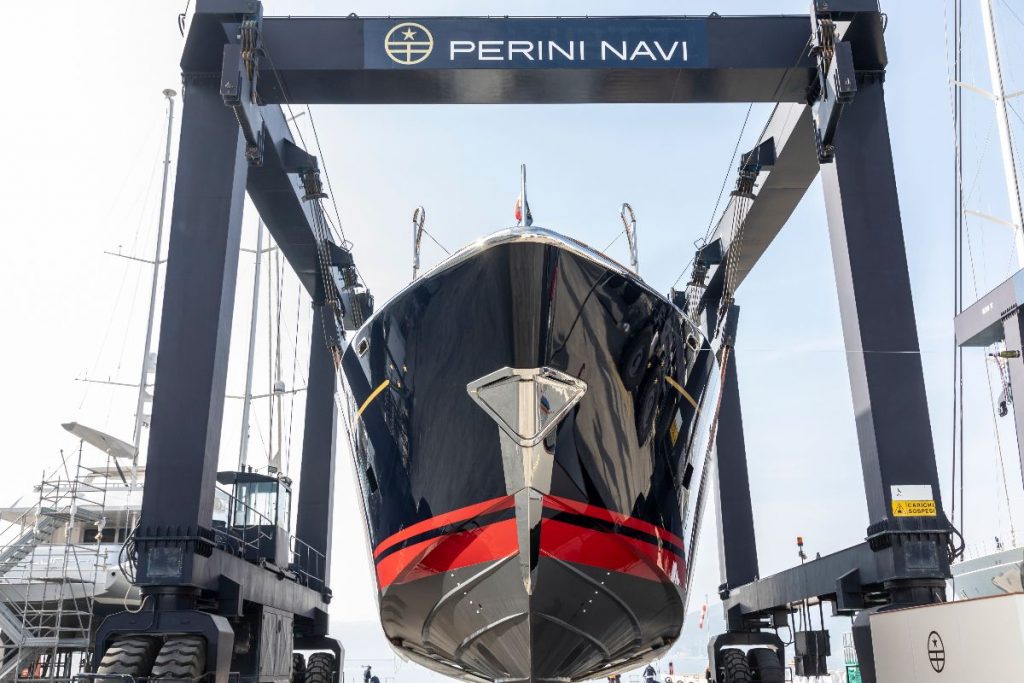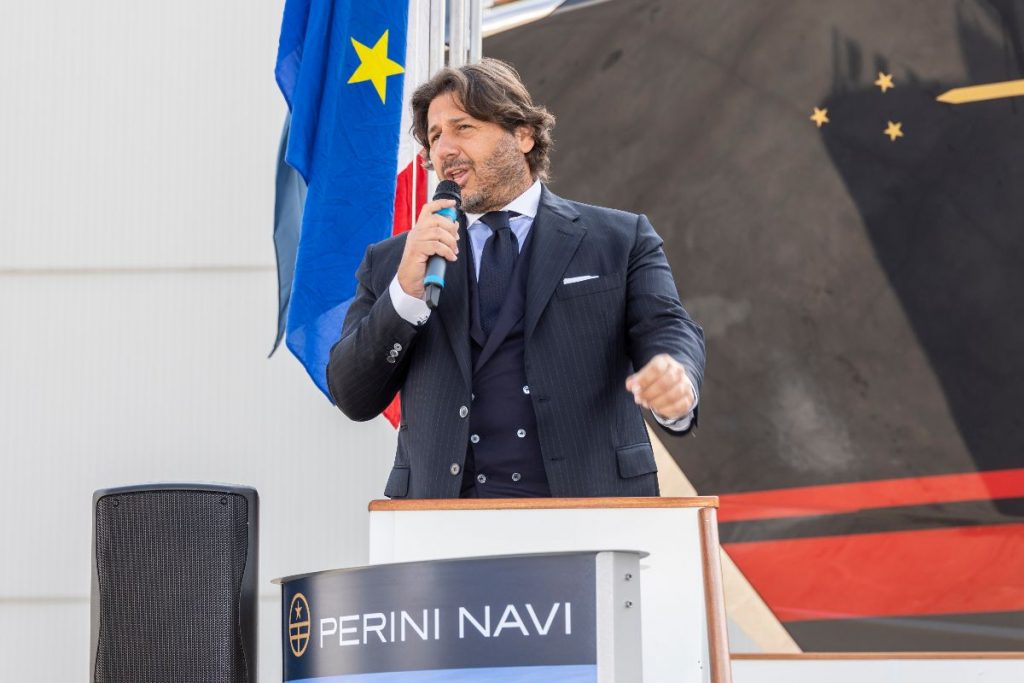
What effectively is a mini superyacht, has been launched by Perini Navi.
It is the company’s first motor yacht launch since dropping the Picchiotti brand name and their first ever planing motoryacht.
Perini Navi tailored the all new 25 metre Eco-tender to meet the requests of her experienced owners.
The mini superyacht project grew out of initial discussions with the owners seeking a bigger sailing boat. During those talks it emerged that the owners were very happy with their existing 52m Perini Navi sailing yacht. But their needs had evolved over the years.
What they really wanted was not a bigger boat, but more flexible cabin space to accommodate single guests or children. As they prefer to anchor offshore, they also wanted to explore closer inshore in something more substantial than a conventional RIB.
The tech-savvy owners also wanted a vessel that impacted on the environment as little as possible.
The answer was a mini superyacht with the same graceful looks, quality feel and luxurious comfort as the mother ship. It means she can also provide additional cabin space and be able to operate independently as an extension of the sailing yacht.
Innovative design
Clearly no ordinary tender this mini superyacht represents a new breed of super-tender with amenities and innovative technologies to match.
The innovations start with a sophisticated 4- Mode hybrid propulsion system developed by Siemens and that provides four operational modes for maximum flexibility:
- Diesel mode: twin MAN diesel engines (2x1213kW) power two Hamilton waterjets for a maximum speed in excess of 30 knots.
- Hybrid mode: one engine drives its neighbouring waterjet and also serves as a generator for an e-motor to power the other waterjet.
- Diesel-electric mode: a 130kW generator supplies electricity for two e-motors to drive the waterjets.
- Zero-emission mode: for completely silent and emissions-free manoeuvring or limited cruising, a battery bank can power both waterjets via the e-motors at around 8 knots for up to a hour.
In battery mode, for example, the tender will be able to cruise at low speed in marine parks or other environmentally sensitive areas with no emissions and no noise. At the same time the owner requested that close attention be paid to minimising noise in all propulsion modes. As a result, the, contractual sound levels are below 55dB throughout.
Advanced navigation and communications
Unusual in a yacht of her size is the I-Bridge Multitouch navigation system. It was created by by Team Italia. As a result, all the onboard systems, including the hybrid propulsion, can be managed using the high-res 4K touch screens, trackball and jogger. This means monitors can be raised to different heights in cockpit or navigation mode. They also include an augmented reality function that overlaps navigation data with video images.

“The classic exterior styling of the Eco-tender shares the same family feeling as Perini Navi’s historic sailing fleet, right down to the dark blue hull and red load line,” says Lamberto Tacoli, Chairman and CEO of Perini Navi.
An Anchor Watch System (AWS) system can display and control all the equipment necessary for monitoring the boat at anchor.
Whats more, it provides a 360° image around the boat and tracking of traffic using the radar systems, thermal camera or search light. It can also be programmed to sound a proximity alarm.
Equipped with a double VSAT system for internet connection and three Iridium telephones. This means the Eco-tender can remain directly connected to the mother ship even when distant by tens of miles.
Functional and flexible design
The owners wanted guests to be able to board or disembark from the tender easily and safely from the deck of the mother ship. The resulting high hull bulwarks mean that guests can literally step across from one deck to the other.
Exterior layout and on-deck amenities continue the innovations. Not only is there lounge seating, sunpads and a fixed swim platform in the comfy aft cockpit, but sunk into the foredeck there is a spacious dinette. This further serves as a viewing area from where the owner can pursue his hobby of nature photography.
The fresh and contemporary interior, is based on brushed teak and white lacquered joinery. It features a full dinette-salon and galley on main deck. Below deck, there is a full-beam VIP suite, a double cabin forward and a third cabin with twin single beds. All have en-suite bathrooms. A crew cabin with independent access is located forward of the engine room bulkhead.
Specification
Length waterline: 21.9m
Beam (max): 5.8m
Draught (loaded): 1.15m
Hull and superstructure: aluminium
Displacement: 68.5 t
Gross tonnage: 76 t
Main engines: 2 MAN V12-1650 (2x1213kW @2300 RPM)
Electric motor: Siemens 2x150kW
Elastic coupling: Vulkan
Waterjet: Hamilton HM531
Max speed: 30 knots
Cruising speed: 8 knots
Range at cruising speed: 1,000 nm
Fuel capacity: 9150 litres
Fresh water capacity: 1300 litres
Generators: Siemens Custom 1×135 kWe
Bow Thruster: Quick Italia 15kW
Infotainment: Videoworks
